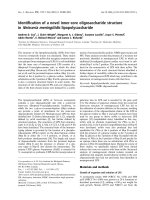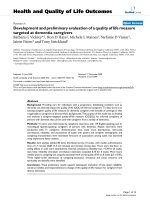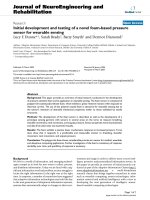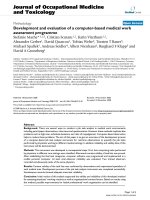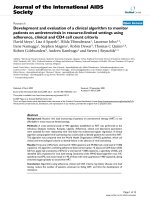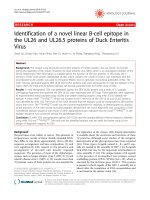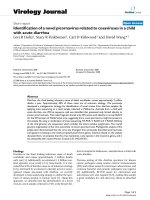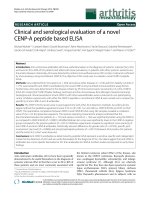Development and performance evaluation of a novel dynamic headspace vacuum transfer “In Trap” extraction method for volatile compounds and comparison with headspace solid-phase
Bạn đang xem bản rút gọn của tài liệu. Xem và tải ngay bản đầy đủ của tài liệu tại đây (3.2 MB, 11 trang )
Journal of Chromatography A, 1601 (2019) 60–70
Contents lists available at ScienceDirect
Journal of Chromatography A
journal homepage: www.elsevier.com/locate/chroma
Development and performance evaluation of a novel dynamic
headspace vacuum transfer “In Trap” extraction method for volatile
compounds and comparison with headspace solid-phase
microextraction and headspace in-tube extraction
Pascal Fuchsmann ∗ , Mireille Tena Stern, Patrick Bischoff, René Badertscher,
Katharina Breme 1 , Barbara Walther
Agroscope, Schwarzenburgstrasse 161, CH-3003 Berne, Switzerland
a r t i c l e
i n f o
Article history:
Received 25 February 2019
Received in revised form 10 May 2019
Accepted 10 May 2019
Available online 22 May 2019
Keywords:
In-tube extraction
Vacuum-transfer in trap
Reduced pressure sampling
Dairy matrix
Response surface methodology
GC–MS
a b s t r a c t
Headspace in-tube extraction (HS-ITEX) and solid phase microextraction (HS-SPME) sampling, followed
by gas chromatography-mass spectrometry (GC–MS), are widely used to analyze volatile compounds in
various food matrices. While the extraction efficiency of volatile compounds from foodstuffs is crucial for
obtaining relevant results, these efficiency of these extraction methods limited by their long extraction
times and requirements for large sample quantity. This study reports on the development and application of a new extraction technique based on HS-ITEX hardware, which improves the extraction rate
and capacity by operating under reduced pressure, called Dynamic Headspace Vacuum Transfer In-Trap
Extraction (DHS-VTT). The results of the study indicate that DHS-VTT improves the extraction of the
target compounds. The area of the mass spectrometer signal for each compound can be up to 450 times
more intense than the HS-SPME and HS-ITEX techniques performed in the same experimental conditions
of extraction temperature and time. DHS-VTT runs in automated mode, making it possible to work with
smaller sample quantity and also favors the HS extraction of all volatile compounds. In addition, the necessary modifications to the installation were cheap and the life of an ITEX trap is up to 10 times longer
than an SPME fibre.
© 2019 The Authors. Published by Elsevier B.V. This is an open access article under the CC BY-NC-ND
license ( />
1. Introduction
In food and flavor analytics, maintaining sample quality is
a significant challenge throughout the analytical workflow. A
commonly used method for performing sampling of food is by
headspace (HS) techniques. Although they are “clean” techniques
with respect to the working environment and installations, from
our experience they have several drawbacks depending on use
such as: Extended heat treatment and extraction time, which can
result in artifact formation, change of the molecular structure, and
even degradation of the sample. Automated HS-microextraction
sampling techniques perform extraction and injection into the gas
chromatograph (GC) in a single step, but often result in a discriminative transfer of compounds from the sample into the headspace.
∗ Corresponding author.
E-mail address: (P. Fuchsmann).
1
Current address: ELSA-Mifroma Group, CH-1470 Estavayer-le-Lac, Switzerland.
Phase partition coefficients air-water (Kaw ), sorbent-air (Ksorb-a ),
and sorbent-water (Ksorb-w ) are the three factors that influence the
phase distribution during the extraction for a system in equilibrium [1]. Headspace solid-phase microextraction (HS-SPME) is a
cheap, simple and sensitive automated technique for extracting
volatile organic compounds (VOCs) from a complex matrix without specific sample preparation. However, our own experience
shows that it is very difficult to make robust and accurate analytical methods using HS-SPME. To overcome certain drawbacks of
HS-SPME, and add dynamic and automated features at the same
time, ‘in-tube extraction’ (ITEX) was introduced in 2006 by CTC
Analytics AG (Zwingen, Switzerland). The technique is generally
operated using a multifunctional autosampler. HS-ITEX is a solventless dynamic HS microextraction technique derived from several
other similar techniques (such as SPME and stir bar sorptive extraction (SBSE)) listed and described by Jochmann et al. [2]. HS-ITEX is
a sequential extraction based on progressive dilution and extraction of the headspace on the sample. This extraction technique is
related to the multiple headspace extraction method (MHE) [3–6]
/>0021-9673/© 2019 The Authors. Published by Elsevier B.V. This is an open access article under the CC BY-NC-ND license ( />0/).
Table 1
GC/MS Detection Parameters for the Investigated Compounds and Validation Parameters of the DHS-VTT Method.
P. Fuchsmann et al. / J. Chromatogr. A 1601 (2019) 60–70
NA: Not available.
61
62
P. Fuchsmann et al. / J. Chromatogr. A 1601 (2019) 60–70
and provides an interesting alternative to HS-SPME; it has been
used to extract numerous volatile chemical compounds from various matrices, including food, plants, pollutants, and biological fluids
[2,7–10]. Another similar technique developed by SmartNose SA
(Marin-Epagnier, Switzerland), Inside Needle Dynamic Extraction
(INDEX), uses the same concept of extraction as HS-ITEX, and further HS extraction techniques have been extensively reviewed in
the literature [11]. Improvement of the different parameters of the
HS-ITEX is required to achieve adequate signals through optimized
extraction and thermal desorption [7,12]. The HS-ITEX key parameters are the nature of the sorbent material, the number of strokes
(according to the literature: between 20 and 120 [2,3,8,10,13]), the
extraction speed, the desorption speed, the sample, the trap and
syringe temperature, and the headspace volume extracted. Many
commercial extraction polymers were evaluated by Laaks et al. [14]
and are available on the market. The trap can also be filled with
noncommercial sorbents, such as multiwalled carbon nanotubes
or polystyrene-divinylbenzene [1,9,15]. The choice of the sorbent
material is made based on the target molecule to be extracted. An
innovative technique developed by Barajas et al. [16] also makes
it possible to evaluate and characterize sorbents by inverse gas
chromatography column.
Depending on the matrix and desired results, improving different parameters may be required, making the optimization of the
technology very complex compared to HS-SPME [17].
The goal of this study was to develop and optimize a reproducible, robust, and sensitive extraction method that reduces the
drawbacks of traditional headspace extraction techniques. A new
technique is proposed that combines features of HS-ITEX and principles of vacuum-HS-SPME and vacuum distillation coupled with
gas chromatography [18–21]: Dynamic Headspace Vacuum Transfer In Trap Extraction (DHS-VTT). The new method aimed to avoid
strokes, the limited injection volume and provide dynamic extraction under vacuum conditions. Several publications have reported a
significant improvement of the extraction under reduced-pressure
using so-called vacuum HS-SPME [22–24]. However, this technique
can up to now only be used manually. To address this lack, the
current method was designed to function with an automatic mode.
This paper discusses the development and application of our
new extraction technique, DHS-VTT using a model of an artificially
constructed matrix (ACM). We assess the method’s sensitivity, and
its suitability for the qualitative and quantitative analysis of a broad
range of volatile compounds, small sample volume, and large sample series. The suitability and efficiency of DHS-VTT were verified
by comparison to HS-SPME and HS-ITEX, as well as analysis of ACM
and plain yoghurt using parameters commonly found in the literature for HS-ITEX and HS-SPME [25].
2. Experimental
2.1. Materials and methods
2.1.1. Chemicals and samples
The relevant chemical compounds were purchased from SigmaAldrich Chemie GmbH (Buchs, Switzerland), R.C. Treatt & Co. Ltd
(Suffolk, United Kingdom), and Caesar & Loretz GmbH (Hilden,
Germany): Hexan-1-ol (Aldrich 471402), 2-Phenylethanol (Aldrich
77861), Butan-2-one (Aldrich 360473), Butane-2,3-dione (Aldrich
B85307), 3-Hydroxybutan-2-one (Aldrich W200808), Heptan2-one (Aldrich W254401), Undecan-2-one (Aldrich W309311),
Ethyl butanoate (Aldrich W242705), Ethyl 3-methylbutanoate
(Aldrich W246301), Ethyl hexanoate (Aldrich W242906), Ethyl
decanoate (Aldrich W243205),␥-Butyrolactone (Aldrich 90970),
␦-Decalactone (Aldrich W236101), (Z)-6-Dodecen-4-olide (R.C.
Treatt 62185), Butanal (Aldrich W221902), 3-Methylbutanal
Table 2
Two-level full factorial design of experiment for the method validation.
Design
Sample temperature [◦ C]
Extraction time [min]
1
2
3
4
5
6
7
8
9
10
11
12
37
37
73
73
30
80
55
55
55
55
55
55
13
52
13
52
33
33
5
60
33
33
33
33
Changed parameters: sample temperature (37 ◦ C–80 ◦ C) and extraction time
(5–60 min).
(Aldrich 146455), Hexanal (Aldrich 115606), (E)-Hex-2-enal
(Aldrich W256005), 2-Phenylacetaldehyde (Aldrich W287407),
Nonanal (Aldrich W278203), (2E,4E)-Nona-2,4-dienal (Aldrich
W321206), Acetic acid 99.7% (Aldrich 695092), Propanoic acid
(Aldrich P1386), 2-Methylpropanoic acid (Aldrich W222208),
Butanoic acid (Aldrich W222119), 3-Methylbutanoic acid (Aldrich
W310212), 4-Methylpentanoic acid (Aldrich W346306), Hexanoic acid (Aldrich W255904), Octanoic acid (Aldrich W279927),
Decanoic acid (Aldrich W + 236411), Dodecanoic acid (Aldrich
61609), Pentane (Aldrich 236705), Hexane (Aldrich 296090), Heptane (Aldrich 246654), Octane (Aldrich 296988), Nonane (Aldrich
296821), Decane (Aldrich 457116), Undecane (Aldrich W510505),
Dodecane (Aldrich 297879), Tridecane (Aldrich T57401), Tetradecane (Aldrich 172456), Pentadecane (Aldrich P3406), Hexadecane
(Aldrich 296317), Polyethylenglycol 200 (Aldrich P3015), Miglyol
812 (Caesar 3274), Sodium chloride > 99% (Aldrich S9888), and
phosphoric acid (Aldrich W290017). Plain yoghurt (3.5% fat) was
purchased from a local supermarket.
2.1.2. ITEX sorbent materials
®
®
ITEX traps filled with Tenax TA (TTA), Tenax GR (TGR),
®
Cabosieve S III (CSIII), and Cabosieve S III/Tenax TA (CSIII/TTA)
were purchased from BGB Analytik AG, Boeckten, Switzerland.
2.1.3. Artificially constructed matrix (ACM)
To develop and optimize the DHS-VTT technique, a stable
sample was prepared using 43 target compounds representing
chemical families that are often present in dairy matrices (alcohols, ketones, aldehydes, alkanes, carboxylic acids, and lactones;
see Table 1), all diluted to a concentration of 10 mg L−1 in 20 mL
of polyethylene glycol 200. The alkanes were separately diluted in
®
Miglyol 812 at the same concentration. Polyethylene glycol 200
was chosen because it is a good solvent for the selected compounds
and does not react with the volatile compounds present in the ACM.
The compounds that are not soluble in polyethylene glycol 200 (the
®
alkanes) were dissolved in Miglyol 812 which also simulates the
lipid part of a dairy matrix. These mixtures were stored at −40 ◦ C
until analysis.
2.1.4. Sample preparation
ACM standard solutions (25 L of each standard) was diluted
with H3 PO4 4% in deionized water at pH 1.3 (total sample volume of
two millilitres) and placed in 20 mL HS vials (Interchim, Montluc¸on,
France). The acidification of the sample helps to promote the
volatility of carboxylic acids. Phosphoric acid is not volatile and
will not interfere in the analyses either. The vials were hermetically
sealed using a blue silicone/Teflon septum (Interchim). Calibration
curves were made by diluting the stock solution by a factor of two
for a minimum of seven points. To facilitate data processing, the 43
Table 3
Comparison between DHS-VTT with different sorbent materials, HS-ITEX TTA and HS-SPME for the investigated compounds.
P. Fuchsmann et al. / J. Chromatogr. A 1601 (2019) 60–70
63
64
P. Fuchsmann et al. / J. Chromatogr. A 1601 (2019) 60–70
compounds were classified into three groups, based on their molecular weight and volatility as well as elution time: group 1, spanning
over C5 and C10; group 2, spanning over the first peak right after
C10 and C13; and group 3, spanning over the first peak right after
C13 and C20 (Tables 1 and 3).
For real dairy analyses, two millilitres of homogenized plain
yoghurt were placed in 20 mL HS vials (Interchim) and they were
hermetically sealed using a blue silicone/Teflon septum (Interchim).
2.1.5. Modification of the gas distribution block
The original two-way aluminum gas distribution block of the
autosampler MPS2 (Gerstel, Sursee, Switzerland) was replaced by
a three-way block printed on a 3D Touch Pegasus printer (Full
Spectrum Laser, Las Vegas, US) with “Universal Clear Resin” (Full
spectrum Laser) (Fig. 1). The polymer was solidified using UV exposure after printing. This modification makes it possible to switch
the solenoid valve between the vacuum pump and the inert gas to
extract volatile compounds from the sample with the vacuum and
desorb them into the injector using an inert gas flow.
2.1.6. Pressure measurement
In order to verify the hermeticity of the vial, a pressure of
10 mbar was applied in an empty vial using a vacuum pump Buchi
V-300 equipped with a pressure control interface I-300 (Büchi,
Flawil, Switzerland). The vial was connected to a pressure sensor
PAA-27 (Keller, Winterthur, Switzerland) and a measuring device
Almemo 2590 (Ahlborn, Holzkirchen, Germany). The pump was
then stopped and the signal was recorded simultaneously in a csv
file and processed with Excel.
Evaluation of the pressure in the vial during HS-ITEX and DHSVTT extraction was carried out using the same equipment as
described above. The measuring device was connected to a needle which pierces the septum of the vials at the same time that the
extraction was performed. Instrumentation for GC–MS analysis
The analyses were completed using an MPS2 autosampler (Gerstel) on an Agilent 7890B GC system coupled to an Agilent 5977A
mass selective detector (MSD) (Agilent Technology, Santa Clara,
CA, USA). The headspace was extracted according to the experimental design (Table 2). Bound volatiles were desorbed in a PTV
of type CIS 4 (Gerstel). Volatile compounds were separated on a
TRB-FFAP fused silica capillary column (100% PEG with nitroterephthalic acid, bonded and crosslinked, 60 m ×0.32 mm ×1.0 m film;
Teknokroma, Barcelona, Spain) with helium as the carrier gas at a
constant flow of 2.5 mL min−1 (30 cm sec−1 ).
The oven temperature program was as follows: five minutes at
40 ◦ C, then heated to 220 ◦ C at a rate of 5 ◦ C min−1 , with a final
hold time of 34 min to make a total run time of 75 min. The MS
settings were as follows: the transfer line at 230 ◦ C, the source
temperature at 230 ◦ C, the compounds monitored in SCAN mode
between 29 amu and 250 amu without solvent delay, and in SIM
mode for the method detection limits (MDLs) and the calibration
curves. The autosampler was controlled using the Cycle Composer
V. 1.5.4 (CTC Analytics, Zwingen, Switzerland) and the PTV injector with Maestro1 software V.1.4.8.14/3.5 (Gerstel). The detector
response signals were integrated using Masshunter quantitative
analysis software version B.08.00 (Agilent). The NIST/EPA/NIH mass
spectral library (NIST14) version 2.2 (NIST, Gaithersburg, MD, USA)
was used for peak identification.
2.2. Headspace in-tube extraction (HS-ITEX)
The ITEX-2 option (Brechbühler, Schlieren, Switzerland) was
used on the MPS2 autosampler. The headspace was extracted using
a TTA trap with 70 extraction strokes (volume of 1.3 mL/stroke,
extraction flow rate of 100 L s −1 ). ACM and yoghurt samples were
not conditioned for this experiment. The syringe temperature was
fixed at 100 ◦ C, the ITEX trap at 35 ◦ C, and the sample at 55 ◦ C. The
bound volatiles were desorbed from the sorbent material at 240 ◦ C
in a CIS4 injector equipped with a glass liner filled with TTA at
10 ◦ C. A volume of 1.3 mL was transferred into the injector at a desorption flow rate of 100 L s −1 , after having waited 30 s (plunger
down) in the vent mode (50 mL min−1 , set pressure: 0 kPa). The
injector was then heated at a rate of 12 ◦ C s −1 to 240 ◦ C. The purge
flow to split vent was set at 300 mL min−1 after 5 min. After injection, the ITEX needle was reconditioned according to the supplier’s
temperature recommendation for 15 min under a nitrogen flow of
220 mL min−1 (measured at 35 ◦ C).
2.2.1. Headspace solid-phase microextraction (HS-SPME)
To obtain a representative evaluation of the VOCs of the samples,
the VOCs were extracted using a 1 cm 50/30 m divinylbenzene/carboxen/polydimethylsiloxane (DVB/CAR/PDMS) StableFlex
fibre (Supelco, Bellefonte, PA, USA). The fibre was conditioned
according to the supplier’s recommendations (270 ◦ C for 60 min).
ACM and yoghurt samples were not conditioned for this experiment. The sample headspace was extracted for 30 min at 55 ◦ C with
an agitation rate of 250 rpm. The bound volatiles were desorbed for
60 s at 240 ◦ C in the injector, which was in the splitless mode for 60 s
before the split valve was opened (split flow =80 mL min −1 ) [25].
2.2.2. Dynamic headspace vacuum transfer in trap extraction
(DHS-VTT)
DHS-VTT requires the same equipment as HS-SPME and HS-ITEX
methods. A vacuum pump with pressure control interface and the
new gas distribution block complete the installation (Fig. 2 A).
đ
A piece of cleaned swab Topper 8 10 ì 10 cm (Systagenix, North
Yorkshire, United Kingdom) was added to the vial to avoid boiling and foaming. The syringe temperature was fixed at 100 ◦ C, the
ITEX trap at 35 ◦ C, and the sample according to the experimental
design (Table 2). The extraction takes place as illustrated (Fig. 2B).
Sample conditioning: ACM and yoghurt samples were not conditioned for this experiment. Extraction: The trap pierces the septum
and the plunger rises to the upper position. When the plunger
is in the upper position, the HS was extracted under continuous
reduced pressure using a vacuum pump Buchi V-300 equipped with
a pressure control interface I-300 (Büchi) and the gas distribution
block according to the experimental design (Table 2) without agitation. Drying: The trap was then removed from the sample and the
solenoid valve switches to nitrogen. Sorbent and syringe were dried
under a nitrogen stream for 17 min at 220 mL min − 1 [26]. Desorption: The trap was then introduced into the PTV injector and the
bound volatiles were desorbed from the sorbent for 120 s with a
nitrogen flow of 220 mL min−1 (fixed at 35 ◦ C) at 240 ◦ C. The PTV
injector was in the vent mode at 50 mL min−1 and 0 kPa for 120 s.
The injector was equipped with a glass liner filled with TTA and
cooled with liquid nitrogen at 10 ◦ C. The trap was removed from
the injector and the injector was then heated, at a rate of 12 ◦ C s−1 ,
to 240 ◦ C. The purge flow to split vent was set at 300 mL min−1 after
5 min. Trap Cleaning: The reconditioning of the trap was achieved
in the same way as for the HS-ITEX method by circulating a flow of
nitrogen through the trap at the recommended temperature with
the plunger in the upper position.
2.3. Experimental design and statistics
To optimize experimental parameters, a two-level full factorial design of the experiment was performed. Only the sample
temperature and the time of extraction were investigated because
these are the parameters that have the most easily modifiable and
have the greatest impact on the extraction of volatile compounds.
The temperature of the trap should be kept as low as possible
P. Fuchsmann et al. / J. Chromatogr. A 1601 (2019) 60–70
65
Fig. 1. Design of the modification of the gas distribution block in polymer (dimension in mm). The block was designed with three ways, one for the nitrogen supply (A), one
for the vacuum (B), and the last way was directly connected to the autosampler.
Fig. 2. (A) Diagram of the GC–MS instrument with the autosampler (MPS2) and ITEX-2 hardware. Connection of the original nitrogen line to the new distribution block (in
orange) and the solenoid valve. The vacuum and nitrogen lines are coloured green and blue respectively. (B) Stages of the extraction process using the DHS-VTT method.
Sample conditioning, extraction, drying, desorption and trap cleaning steps.
66
P. Fuchsmann et al. / J. Chromatogr. A 1601 (2019) 60–70
Fig. 3. Parameter optimization according to the experimental design for DHS-VTT (TTA/CSIII). X-Axis: Sample temperature [◦ C]. Y-Axis: Extraction time [min]. Z-Axis: Total
ion count normalized [-]. The color variations represent blue for a low signal and red for a high signal.
(within the constraints of the instrument specifications and the
laboratory environment) and the syringe temperature kept at
100 ◦ C to exclude water condensation during the extraction. Three
centrally composed DHS-VTT experimental plans were developed.
The respective results were evaluated and presented to show the
areas of effect. Mosaic plots (Fig. 3), which can be interpreted using
color, were chosen for the present work, and each peak area of
effect was smoothed squarely (smoothing method). In the plots,
the intensity of the peak area observed is displayed in color, from
blue (no signal), through dark and light green, yellow-orange,
and, finally, to red, the largest and most intense peak area, which
is equivalent to the maximal signal. The mean values of these
measurement ranges were the center of the Central Composite
design. The remaining levels were placed radially around the
center in a 2 * 22 experiment, which corresponds geometrically to
two squares, rotated by 45◦ in the plane around their center. This
design allows for the influence of five levels per parameter. Height
points are distributed around the center at the same relative
distance. In total, 12 measuring points are made, the center point
for the variability being measured four times.
3. Results and discussion
3.1. Extraction parameters
3.1.1. Pressure in the headspace
The effectiveness of blue silicone/Teflon septum in the hermeticity of vials has shown that the pressure remained stable for a period
of 10 min after the pump was stopped and thus can be considered
as sufficiently effective for the analyses (results not shown).
The pressure measurements made during the extraction according to the HS-ITEX method show that the extractions were carried
out above atmospheric pressure due to air expanding in the
vial during extraction when it was heated. The sample was prepared at atmospheric pressure before extraction then placed in
the autosampler cooling device (4 ◦ C). The pressure immediately
decreased due to the volume contraction of the air in the vials.
Then the vial was placed in the heating agitator (55 ◦ C), and the
pressure increased above the atmospheric pressure (Fig. 4, red signal). Throughout extraction, the high pressure remained constant.
As a result, the rate of evaporation of the compounds decreases and
the extraction efficiency of volatile compounds was thus lower [27].
This phenomenon was similar during an HS-SPME extraction
without the strokes effect. With the change of the gas distribution
block, it was possible to automate the extraction at reduced pressure in the vial throughout the extraction (Fig. 4, green signal). The
Fig. 4. The pressure inside the vials during extraction using HS-ITEX (red) and DHSVTT (green) method at set pressure: 100 mbar.
vacuum obtained in the vials greatly influenced the extraction of
volatile compounds [22]. A pressure above 100 mbar was no longer
sufficient for extracting the compounds efficiently (Fig. 5). Reduced
pressure accelerated the release of the volatile compound in the
headspace, but also has an impact on the efficiency of the sorbent.
Low pressure over a long period of time desorbs the most volatile
compounds of the sorbent. Consequently, it was necessary to determine the optimal conditions for achieving a suitable compromise
between the pressure in the vial and the extraction rate. The pressure effects depended on the volatility of the molecules. The highly
volatile compounds as the pentane were better retained on the
polymer when the pressure in the vial was not less than about
50 mbar (data not shown), while other volatile compounds were
more easily extracted at the lowest possible pressure. The effect
of the reduced pressure during extraction caused an issue already
known from the purge and trap technology—the accumulation of
water vapor in the system (needle, syringe, tubes) and artifact formation [12,26]. To avoid this, the trap and the syringe were dried
under a nitrogen flow for a time determined prior to injection into
the injector.
3.1.2. Sample volume and HS volume
Tests were conducted using sample volumes of 0.5, 1, 2 and
4 mL in 20 mL HS vials. The DHS-VTT parameters were the same
P. Fuchsmann et al. / J. Chromatogr. A 1601 (2019) 60–70
67
Fig. 5. The sum of the peak areas of the 43 target compounds divided into three groups (Y-Axis: Total ion count) as a function of the pressure in the vials, expressed in mbar
(set pressure) (X-Axis).
trap was not reached, allowing for quantitative studies using a 2 mL
sample [28,29].
3.1.3. PTV injector temperature
Low temperature in the liner had a positive impact on the recovery of volatile compounds. The change from 10 ◦ C to −50 ◦ C does
not show a significant improvement in recovery of volatile compounds for groups 2 and 3. For reasons of cost and efficiency, we
used a temperature of 10 ◦ C for the PTV (Fig. 7).
Fig. 6. Influence of the sample amount on the total ion count (TIC) MS signal of the
target compounds.
for each test. The amount of the sample, and, consequently, the
number of volatile molecules available in the vials influenced the
extraction. When the amount of the sample doubled, the total signal increased proportionally by a factor of 1.7 for a given extraction
time (Fig. 6). This demonstrates that the extraction capacity of the
3.1.4. Sample temperature and extraction time
The effect of the sample temperature was evaluated for temperatures between 30 and 80 ◦ C using the described experimental
design (Table 2). Increased temperature led to an increase in the
signal for all compounds due to a higher partitioning of compounds from the aqueous phase to the headspace [1]. The higher
the temperature, the higher the extraction efficacy for the less
volatile compounds. At certain high temperatures, the compounds
degraded and tended to contaminate the autosampler, i.e., water
vapor condensed in the trap, the syringe, and the autosampler
tubes. Despite the hydrophobic nature of TTA, an accumulation of
water in the trap could result in the problem of injecting water
droplets into the GC with the injection of the compounds [26].
Fig. 7. Influence of the PTV injector temperature on the recovery of the investigated compounds after injection. The injector temperature was tested between 20 ◦ C and
−50 ◦ C.
68
P. Fuchsmann et al. / J. Chromatogr. A 1601 (2019) 60–70
3.2. Comparison of HS-SPME, HS-ITEX, and DHS-VTT
Fig. 8. Influence of the thermodesorption temperature on the nitrogen flow inside
the ITEX trap.
With a reduced pressure in the vials, we observed that the
extraction rate accelerated. For the most volatile compounds, a
prolonged extraction time had a negative effect on the recovery
of the molecules [1]. Indeed, when extraction time was too long,
the most volatile compounds were released from the sorbent. For
the majority of the molecules studied in ACM, the results of the
experiment showed an optimal time of 30 min at 55 ◦ C. The extraction parameters can be adapted according to the molecules to be
studied (Fig. 3).
3.1.5. Nitrogen flow desorption
The nitrogen flow was optimized to 220 mL min−1 at 35 ◦ C to
allow for proper desorption of the compounds fixed to the polymer
and extraction to counteract against the pressure into the injector
during desorption. An exponential decrease in the nitrogen flow
rate was noted when the temperature of the trap increased (Fig. 8).
A too-high flow (>300 mL min−1 ) sometimes clogged the trap by
sealing the sorbent material.
The results indicate that DHS-VTT clearly improves the extraction of volatile compounds from a complex matrix as the ACM
(Table 3). The peak area can be increased by a factor of 450
for some compounds in comparison with using the HS-SPME
method. In comparison, HS-SPME extraction, widely used in common headspace applications, achieves lower efficiency for all
compounds measured under the same temperature and extraction
time conditions. The DHS-VTT technique enriches the gas phase
rapidly by limiting the matrix effects because of the reduced pressure in the vial. Moreover, the conventional HS-ITEX method cannot
extract the least volatile compounds. The headspace is rapidly in a
stable state in HS-ITEX, and the strokes are inadequate to extract
more volatile compounds. The choice of polymer in the DHS-VTT
extraction trap was also very important for optimal extraction. The
best compromise for the 43 compounds used in this study was the
Tenax TA/Carbosieve SIII blend.
The profiles of the volatile fraction obtained for a plain yoghurt
using the DHS-VTT, HS-ITEX, and HS-SPME extraction methods
show that the DHS-VTT method was suitable for this type of sample
(Fig. 9). The analyses performed on the yoghurt confirm the results
obtained with the ACM. The HS-ITEX method was effective for the
extraction of highly volatile compounds such as acetaldehyde but
did not extract heavier compounds under the described conditions.
With the HS-SPME all compounds except the decanoic acid could
be identified. However, the signals were much weaker than with
the DHS-VTT method. The surface area of the peaks was higher with
DHS-VTT and a higher number of compounds could be detected in
SCAN mode using this method.
3.3. Performance evaluation of DHS-VTT
Performance evaluation was carried out by determining the following parameters:
• The linearity (R2 ) of the method was evaluated by measuring
the target compounds in six different concentrations in the ACM
corresponding to the ranks commonly found in dairy matrices.
Fig. 9. Chromatograms corresponding the volatile fraction of plain yoghurt extracted by DHS-VTT, HS-ITEX and HS-SPME methods. The chromatographic conditions
were given in Section 2.2 Instrumentation for GC–MS analysis (sample temperature 55 ◦ C, extraction time 30 min). Peak numbers correspond to : 1:Acetaldehyde,
2:Acetone, 3:Ethylacetate, 4:Butan-2-one, 5:Butane-2,3-dione, 6:Pentane-2,3-dione, 7:Hexanal, 8:Heptan-2-one, 9:Octanal, 10:3-Hydroxy-butan-2-one, 11:2-Methylpentan3-ol, 12:2-Hydroxy-3-pentanone, 13:Nonan-2-one, 14:Nonanal, 15:Acetic acid, 16:Propanoic acid, 17:2-Methylpropanoic acid, 18:Undecan-2-one, 19:Butanoic acid,
20:2-Phenylacetaldehyde, 21:Pentanoic acid, 22:Hexanoic acid, 23: 6,10-dimethylundeca-5,9-dien-2-one, 24:2-Phenylethanol, 25:Octanoic acid, 26:Nonanoic acid, 27:
␦–Decalactone, 28:Decanoic acid, 29: ı-Dodecalactone. A, Artifact.
P. Fuchsmann et al. / J. Chromatogr. A 1601 (2019) 60–70
69
Fig. 10. 850 injections of the ACM sample over two weeks in DHS-VTT. Y-axis: Sum of the peak areas of the 43 molecules selected. Standard deviation 9.6%.
The R2 was approximately 0.99 +/- for all compounds except for
␥-butyrolactone with 0.98.
• The MDL of the target molecules was estimated according to the
US Environmental Protection Agency procedure and Eq. (1):
MDL = t(N−1, 1−∝=0.99) × Sc
(1)
• where t is the student’s t value with a confidence level of 99%
and six degrees of freedom and Sc the standard deviation of seven
replicates at a concentration level featuring a signal-to-noise ratio
(S/N) of three to one. The MDLs measured for alkanes ranged from
0.036 g L−1 to 0.822 g L −1 , for esters from 0.003 g L −1 to
0.071 g L −1 , for aldehydes from 0.050 g L −1 to 2.89 g L −1 ,
for ketones from 0.145 g L −1 to 11.9 g L −1 , for lactones from
0.130 g L −1 to 0.195 g L −1 , for alcohols from 0.032 g L −1 to
0.127 g L−1 , and for the carboxylic acids from 0.741 g L −1 to
104 g L−1 (Table 1).
• The reproducibility (RSD%) was obtained by determining the relative standard deviation calculated on the analyses of the samples
eight times over a period of two weeks. Reproducibility was
measured between 2.2 and 33% for all compounds (Table 1).
Reproducibility was low for the carboxylic acids; the extraction
conditions were not optimized for these compounds.
• The extraction ratio (E) of the method was evaluated by extracting
the same sample five times. The E value was calculated according
to Zimmermann et al., by plotting the logarithmical peak areas
against the number of extraction and a simplified Eq. (2) [30].
The slope of the linear regression is represented in the equation
by the log (1 - E).
lognf,x = log ns,0 E + (x − 1) log (1 − E)
(2)
The E value ranged from 1.0% for dodecanoic acid to 77.8% for butan2-one.
• 850 injections of ACM were made using the same ITEX trap. The
results show the reproducibility and stability of the analyses, with
a maximum variation of 9.6% between the two extreme results
(Fig. 10).
4. Conclusions
This newly developed DHS-VTT technique improves the extraction of volatile compounds from an ACM by a simple and
inexpensive modification of the autosampler and by using commercial ITEX hardware. Using the principle of DHS-VTT provides a
rapid extraction of target compounds with minimal damage to the
sample and limited artifact formation. Working at reduced pressure
increases the evaporation rate of the compounds. Extraction under
continuous reduced pressure avoids creating a system in equilibrium, and, thus, extraction remains dynamic. Our results show good
repeatability and sensitivity for the majority of the target molecules
assessed.
Comparing the results of extraction by DHS-VTT (TTA, TGR, CSIII,
and TTA/CSIII), HS-ITEX (TTA) and HS-SPME (DVB/CAR/PDMS), we
observe that DHS-VTT shows benefits for both time and sensitivity of extraction for volatile compounds, including group 1, group
2, and group 3 (Table 3). The much larger amounts of compounds
extracted with the DHS-VTT method would facilitate more efficient
olfactometric analyses. However, further research is necessary to
compare how representative the different extraction methods are
for odors to validate the developed method for olfactometry profiling. This would also require detailed odor representativeness
studies [31,32].
To the authors’ knowledge, no other publication has reported
on the development of this new DHS-VTT method, which allows for
better extraction of target volatiles using shorter extraction times
and lower temperatures.
Notes
The authors declare no competing financial interest.
Acknowledgements
We thank Dr. Jacques-Olivier Bosset, Dr. Barbara Guggenbühl,
and Dr. Kathryn J Burton for helpful comments on the manuscript.
References
[1] T. Hüffer, X.L. Osorio, M.A. Jochmann, B. Schilling, T.C. Schmidt, Multi-walled
carbon nanotubes as sorptive material for solventless in-tube microextraction
(ITEX2)- as factorial design study, Anal. Bioanal. Chem. 405 (2013)
8387–8395, />[2] M.A. Jochmann, X. Yuan, B. Schilling, T.C. Schmidt, In-tube extraction for
enrichment of volatile organic hydrocarbons from aqueous samples, J.
Chromatogr. A 1179 (2008) 96–105, />11.100.
[3] J. Zapata, R. Lopez, P. Herrero, V. Ferreira, Multiple automated headspace
in-tube extraction for the accurate analysis of relevant wine aroma
compounds and for the estimation of their relative liquid-gas transfer rates, J.
Chromatogr. A 1266 (2012) 1–9, />015.
[4] M.T. Suzuki, S. Tsuge, T. Takeuchi, Gas chromatographic estimation of
occluded solvents in adhesive tape by periodic introduction method, Anal.
Chem. 42 (1970) 1705–1708, />
70
P. Fuchsmann et al. / J. Chromatogr. A 1601 (2019) 60–70
[5] B. Kolb, P. Pospisil, A gas chromatographic assay for quantitative analysis of
volatiles in solid materials by discontinuous gas extraction, Chromatographia
10 (1977) 705–711, />[6] E.A. Tavss, J. Santalucia, R.S. Robinson, D.L. Carroll, Analysis of flavor
absorption into plastic packaging materials using multiple headspace
extraction gas chromatography, J. Chromatogr. A 438 (1988) 281–289, http://
dx.doi.org/10.1016/S0021-9673(00)90259-0.
[7] J. Laaks, M.A. Jochmann, B. Schilling, K. Molt, T.C. Schmidt, In-tube
Extraction-GC-MS as a high-capacity enrichment technique for the analysis of
alcoholic beverages, J. Agric. Food Chem. 62 (2014) 3081–3091, .
org/10.1021/jf405832u.
[8] L. Niu, J. Bao, L. Zhao, Y. Zhang, Odor properties and volatile compounds
analysis of Torreya grandis aril extracts, J. Essent. Oil Res. 23 (2011) 1–6,
/>[9] S.A. Socaci, M. Tofana, C. Socaciu, E. Mudura, C. Muresan, Optimization of
ITEX/GC-MS method for determination of indigenous rosemary volatiles, Bull.
UASVM Agric. 68 (2011) 423–429.
[10] J. Zapata, L. Mateo-Vivaracho, R.F. Lopez, V. Ferreira, Automated and
quantitative headspace in-tube extraction for the accurate determination of
highly volatile compounds from wines and beers, J. Chromatogr. A 1230
(2012) 1–7, />[11] S.B. Ampuero, S. Bogdanov, J.O. Bosset, Classification of unifloral honeys with
an MS-based electronic nose using different sampling modes: SHS, SPME and
INDEX, Eur. Food Res. Technol. 218 (2004) 198–207, />1007/s00217-003-0834-9.
[12] J. Laaks, M.A. Jochmann, B. Schilling, T.C. Schmidt, Optimization strategies of
in-tube extraction (ITEX) methods, Anal. Bioanal. Chem. 407 (2015)
6827–6838, />[13] I. Rasanen, J. Viinamaki, E. Vuori, I. Ojanpera, Headspace in-tube extraction
gas chromatography-mass spectrometry for the analysis of hydroxylic
methyl-derivatized and volatile organic compounds in blood and urine, J.
Anal. Toxicol. 34 (2010) 113–121, />[14] J. Laaks, M.A. Jochmann, B. Schilling, T.C. Schmidt, In-tube extraction of
volatile organic compounds from aqueous samples: an economical
alternative to purge and trap enrichment, Anal. Chem. 82 (2010) 7641–7648,
/>[15] X.L. Osorio Barajas, T. Huffer, P. Mettig, B. Schilling, M.A. Jochmann, T.C.
Schmidt, Investigation of carbon-based nanomaterials as sorbents for
headspace in-tube extraction of polycyclic aromatic hydrocarbons, Anal.
Bioanal. Chem. 409 (2017) 3861–3870, />[16] X.L.O. Barajas, M.A. Jochmann, T. Huffer, B. Schilling, T.C. Schmidt, Sorbent
material characterization using in-tube extraction needles as inverse gas
chromatography column, J. Sep. Sci. 40 (2017) 2390–2397, />10.1002/jssc.201601198.
[17] A. Kremser, M.A. Jochmann, T.C. Schmidt, Systematic comparison of static and
dynamic headspace sampling techniques for gas chromatography, Anal.
Bioanal. Chem. 408 (2016) 6567–6579, />[18] P.J.L. Nyman, W. Limm, T.H. Begley, S.J. Chirtel, Single-laboratory validation of
a method for the determination of select volatile organic compounds in foods
by using vacuum distillation with gas chromatography/mass spectrometry, J.
AOAC Int. 97 (2014) 510–520, />
[19] E. Psillakis, E. Yiantzi, L. Sanchez-Prado, N. Kalogerakis, Vacuum-assisted
headspace solid phase microextraction: improved extraction of semivolatiles
by non-equilibrium headspace sampling under reduced pressure conditions,
Anal. Chim. Acta 742 (2012) 30–36, />019.
[20] M.H. Hiatt, Vacuum distillation coupled with gas Chromatography/Mass
spectrometry for the analysis of environmental samples, Anal. Chem. 67
(1995) 4044–4052, />[21] M.H. Hiatt, Analyses of fish tissue by vacuum distillation/gas
chromatography/ mass spectrometry, Anal. Chem. 69 (1997) 1127–1134,
/>[22] N.P. Brunton, D.A. Cronin, F.J. Monahan, The effects of temperature and
pressure on the performance of carboxen/PDMS fibres during solid phase
microextraction (SPME) of headspace volatiles from cooked and raw turkey
breast, Flavour Fragr. J. 16 (2001) 294–302, />[23] E.K. Yianthi, N. Kalogerakis, E. Psillakis, Vacuum-assisted headspace solid
phase microextraction of polycyclic aromatic hydrocarbons in solid samples,
Anal. Chim. Acta 890 (2015) 108–116, />05.047.
[24] E. Yiantzi, N. Kalogerakis, E. Psillakis, Design and testing of a new sampler for
simplified vacuum-assisted headspace solid-phase microextraction, Anal.
Chim. Acta 927 (2016) 46–54, />[25] P. Fuchsmann, M.T. Stern, Y.A. Brugger, K. Breme, Olfactometry profiles and
quantitation of volatile sulfur compounds of swiss tilsit cheeses, J. Agric. Food
Chem. 63 (2015) 7511–7521, />[26] D. Canac-Arteaga, C. Viallon, J.-L. Berdagué, Analytical artifacts caused by the
presence of water vapor int the headspace of food products, Analusis 28
(2000) 550–556, />[27] E. Psillakis, A. Mousouraki, E. Yiantzi, N. Kalogerakis, Effect of Henry’s law
constant and operating parameters on vacuum-assisted headspace solid
phase microextraction, J. Chromatogr. A 1244 (2012) 55–60, />10.1016/j.chroma.2012.05.006.
[28] T. Gorecki, J. Pawliszyn, Effect of sample volume on quantitative analysis by
solid-phase microextraction. Part 1. Theoretical considerations, Analyst 122
(1997) 1079–1086, />[29] T.K. Gorecki, A. Khaled, J. Pawliszyn, The effect of sample volume on
quantitative analysis by solid phase microextraction. Part 2. Experimental
verification, Analyst 123 (1998) 2819–2824, />A806788K.
[30] T.E. Zimmermann, W.J. Ensinger, T.C. Schmidt, Depletion solid-phase
microextraction for the evaluation of fiber-sample partition coefficients of
pesticides, J. Chromatogr. A 1102 (2006) 51–59, />chroma.2005.10.034.
[31] C. Murat, K. Gourrat, H. Jerosch, N. Cayot, Analytical comparison and sensory
representativity of SAFE, SPME, and Purge and Trap extracts of volatile
compounds from pea flour, Food Chem. 135 (2012) 913–920, .
org/10.1016/j.foodchem.2012.06.015.
[32] S. Mallia, R. Fernandez-Garcis, J.O. Bosset, Comparison of purge and trap and
solid phase microextraction techniques for studying the volatile aroma
compounds of three European PDO hard cheeses, Int. Dairy J. 15 (2005)
741–758, />
